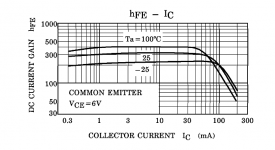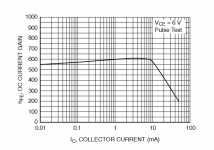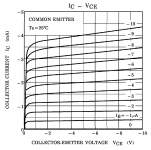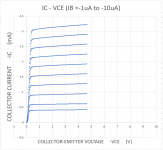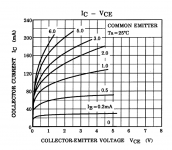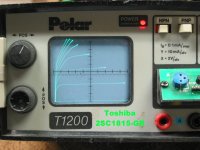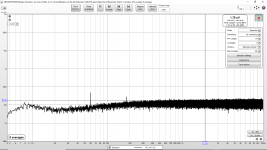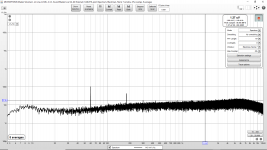Why is there always the impulse to redesign before even hearing it what is already recognized as one of best there is (as evidenced things like by Stereophile choosing at their standard amp for headphone comparisons, multiple product of the year awards, etc.)?
I am not asking due to any desire to redesign the HPA1. I have purchased the KSC1845 and KSA992 from Mouser and I will use them when my PCB arrive.
Instead I would like to understand more (for learning purposes). I have seen the high(er) voltage KSC1845 and KSA992 used in a number of designs and I wonder why I keep seeing them in +/-12V to +/-24V designs. I first encountered the 2SC2240/2SA970 in higher voltage power amplifiers where types like the 2SC1815/2SA1015 did not have high enough breakdown voltages/SOA.
Instead I would like to understand more (for learning purposes). I have seen the high(er) voltage KSC1845 and KSA992 used in a number of designs and I wonder why I keep seeing them in +/-12V to +/-24V designs. I first encountered the 2SC2240/2SA970 in higher voltage power amplifiers where types like the 2SC1815/2SA1015 did not have high enough breakdown voltages/SOA.
Last edited:
I don't know if this sounds ridiculous. However when I have looked at some transistors on a curve tracer and compared with the datasheet I get the feeling that the datasheet curves were almost hand drawn. Sometimes they look a little unrealistic or too good to be true (or too idealistic) on the datasheet and then the actual sample part on the curve tracer looks much more realistic.
I don't have the greatest examples at hand but I have attached a couple where the curve/curvature of the datasheet graphs looks more like it was hand drawn as opposed to being real measured data from a real transistor. (If you notice: Yes I do realize that one of the graphs shows a software bug for the first trace.)
First two attachments: 2SA970. Second two attachments: 2SC1815.
I don't have the greatest examples at hand but I have attached a couple where the curve/curvature of the datasheet graphs looks more like it was hand drawn as opposed to being real measured data from a real transistor. (If you notice: Yes I do realize that one of the graphs shows a software bug for the first trace.)
First two attachments: 2SA970. Second two attachments: 2SC1815.
Attachments
So Ic vs Vce is more important than hfe vs Ic for your ?
Do you intend to run the transistor close to Vce < 2V and varying (i.e not cascoded) ?
Have you curve traced hfe vs Ic ?
Patrick
Do you intend to run the transistor close to Vce < 2V and varying (i.e not cascoded) ?
Have you curve traced hfe vs Ic ?
Patrick
No, I am not saying that is more important. I was talking about the fact that some datasheets seem to have what look like hand drawn graphs. The examples (not the greatest, just what I had quickly at hand) show that. As a result I am not sure I believe the ruler flat hFE curve either. I have more work to do on my DIY curve tracer to extend the current and voltage range. After that I would indeed like to look at hFE vs Ic.
Last edited:
> As a result I am not sure I believe the ruler flat hFE curve either.
I do, because I have measured the Toshiba's, years ago.
Cheers,
Patrick
I do, because I have measured the Toshiba's, years ago.
Cheers,
Patrick
kozard,
I built the original prototypes with the 2SA970BL / 2SC2240BL as Patrick mentioned but switched to the KSC1845/KSA992 for production due to availability. There is not much difference between the two types of device in this design, no changes in compensation or stability. Any good complementary pair with decent beta and similar specs should work. Let's not miss the forest for the trees. 😉
You might try matching devices in the mirrors as an experiment ...........at some point I might put together an update or a (re)design but that might be a year away.
Jam
I built the original prototypes with the 2SA970BL / 2SC2240BL as Patrick mentioned but switched to the KSC1845/KSA992 for production due to availability. There is not much difference between the two types of device in this design, no changes in compensation or stability. Any good complementary pair with decent beta and similar specs should work. Let's not miss the forest for the trees. 😉
You might try matching devices in the mirrors as an experiment ...........at some point I might put together an update or a (re)design but that might be a year away.
Jam
Last edited:
The linearity of the BJT in a 4-TR current mirror is not so critical as long as they are well matched in hfe.
Patrick
Patrick
That is what I mean ..... observe harmonic content if match is radically off, especially if the mirror is also used as a multiplier.😉 Very few diyers are beta matching transistors but this is more of academic interest and should not prevent you from building a fine sounding unit (unless there is a gross mismatch), matching input fets is far more important in my humble opinion.
Jam
Jam
kozard,
You might try matching devices in the mirrors as an experiment ...........at some point I might put together an update or a (re)design but that might be a year away.
Jam
I assume you mean match the hFE of the three upper/mirror KSA992 to each other.
And match the hFE of the three lower/mirror KSC1845 to each other.
I ask since I can match within my one batch of KSC1845. They are pretty consistent. And I can match within my one batch of KSA992. Those are also pretty consistent. However I can not match the KSA992 hFE to the KSC1845. But I assume with this circuit there is no need to do that. (Is that wrong?)
(Typically I sort out the batch by Vbe first and then I match hFE from within a given Vbe "bucket" or in this case plastic organizer compartment. With the typical within-batch consistency that I see the Vbe is matched to 1mV pretty easily.)
Last edited:
Unfortunately I have only one batch of each and the PNP do not match the NPN. However the 100 PNP are quite consistent and the 100 NPN are quite consistent.
Of my other available SS the only ones where the PNP batch matches the NPN batch well are:
1. Fairchild BC546B & BC556B
2. Generic 2N5551 & 2N5401
Not as close but fairly well matched NPN to PNP are:
3. Generic 2SC2705 & 2SA1145
Of my other available SS the only ones where the PNP batch matches the NPN batch well are:
1. Fairchild BC546B & BC556B
2. Generic 2N5551 & 2N5401
Not as close but fairly well matched NPN to PNP are:
3. Generic 2SC2705 & 2SA1145
One might wish to worry more about the power transformer for this thing, given what Jam said about the 6 or 7 design iterations they went through on that. Since custom transformers are probably not practical, what's next best? Toroidy Audio Grade? What rating? Bare minimum? Oversized core?
I would just use KSA/KSC even of there are no perfect N-P match.
BC546/556 is also good, but C grade (higher hfe).
Patrick
BC546/556 is also good, but C grade (higher hfe).
Patrick
One might wish to worry more about the power transformer for this thing, given what Jam said about the 6 or 7 design iterations they went through on that. Since custom transformers are probably not practical, what's next best? Toroidy Audio Grade? What rating? Bare minimum? Oversized core?
Well first I am working on the HPA1 (amplifier portion).
After that I am planning on working on the regulator from the HPA1.
Not sure about the transformer. On my DAC I am using an external transformer from a small mixing console and then two stages of regulation (overkill) including one stage of the LM317/LM337 LF353 servo circuit.
The noise measurements are not bad at all for the LF353 servo circuit. (Attached are measurements from two series LM317/LM337 supplies: Positive and Negative supply. The pre-regulator does not have the LF353, only the second regulator has the LF353. Do those measurements look good enough?)
If I make a PCB for the HPA1 power supply then I can put two regulators in series which would allow me to use one of my spare 150VA toroidal transformers. The voltage is a little high.
Attachments
I would just use KSA/KSC even of there are no perfect N-P match.
BC546/556 is also good, but C grade (higher hfe).
Patrick
When looking at the BC types C vs B grade or -16 -25 vs -40 grades does the hFE linearity suffer with the C and -40 grades? I ask since I am planning to order a few more types (including some surface mount) and I am debating the -C vs -B and the -40 vs -25 grades.
> Does the hFE linearity suffer with the C grades?
What makes you think so ?
You have measurement to support that ?
I only use C grade, so I have no measurements for B or lower.
Patrick
What makes you think so ?
You have measurement to support that ?
I only use C grade, so I have no measurements for B or lower.
Patrick
- Home
- Amplifiers
- Pass Labs
- Pass HPA-1, what do we know?
